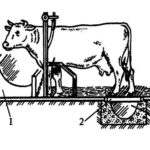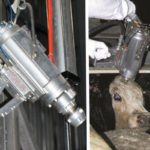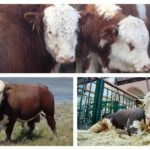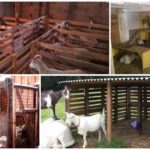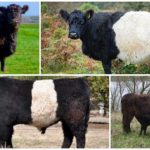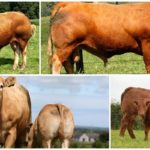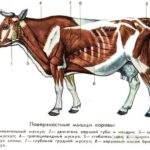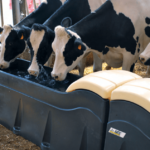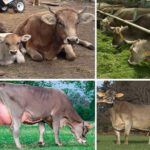The productivity of a farm animal, its health and duration of use are directly affected by its comfort. Cattle (cattle) are no exception. It is important to properly equip the animals' housing - a barn. And also pay special attention to cow stalls - personal space where cattle eat and rest.
Features of building a stall with your own hands
Optimal material for construction barn for cattle In a small farm, boards are used. But stone or brick are suitable alternatives. The first guarantees the strength of the stable. But it has a detrimental effect on the health of animals, which are more likely to get sick in damp concrete conditions.
To make the wooden structure more durable, a foundation is poured. The cement base will ensure the longevity of the shed. At the same time, it will be dry and warm. The stone will be useful for the construction of adjacent walls.
Requirements
When drawing up a preliminary drawing with calculations, the farmer takes as a basis the potential of his capabilities, the availability of ready-made structures available for conversion, area, and the number of heads. When building a barn, it is important to take into account the dimensions of the animal: for fattening bulls one size is provided, for more “fragile” cows - another, and for calves - another.
But there are points that should not be forgotten when organizing a barn with a stall:
- the site for construction is selected on a hill;
- drainage needs to be done in the building;
- think over the conditions for securing the cow during milking and for feeding;
- the belt or rope should not cause discomfort when moving up and down;
- Tethered cows need free entry/exit into the stall, as well as movement around the barn.
Schemes and drawings
When calculating the parameters of an individual place for a farm animal, not only the overall dimensions of the individual are taken into account, but also the space necessary for the comfortable movement of a cow or bull. The dimensions of the stall for tethered cattle are calculated according to the table. The figures given in it are averaged and vary depending on the size of the individual: a bull will require more space, as will cows who like to lie down more.
Table. Approximate figures for calculating the size of the stall:
| Options | Distance, m |
| Lengths from shin above knees to back | 1,6-1,8 |
| Head volume | 0,5 |
| Extra room to maneuver | 0,5 |
Pen length
Based on this parameter, livestock specialists distinguish several types of barns. The main ones:
- Long (more than 2 m). The main disadvantages are increased labor costs and an irrational attitude towards the territory. The minus may affect milk yield.
- Medium (1.7-2 m). Optimal range for tethered cattle keeping. Production indicators do not suffer, the farm feels relatively free.
- Shortened (1.1-1.4 m). Length too short for the animal. Under such conditions, the rear septum injures the cow's udder, causing mastitis.
Width
The absolute unit for adult cattle is 1 m. It is permissible to reduce the value to 0.8 m when keeping young animals up to 20 months old. In general, the calculation is carried out taking into account the characteristics of the content group.
Table. Stall parameters according to cattle type (tied method):
| View | Width, m | Length, m |
| Dry and milking | 1,0-1,2 | 1,7-2 |
| Deep pregnancy | 1,2-2 | 2,0 |
| Novotelnye | 1,2 | 2,0 |
| Meat (fattening cows and bulls) | 0,9-1,0 | 1,7 |
| For sires | 1,5 | 2,0 |
Several methods are used for calves. Conservative involves keeping them in a cage in an insulated room with wooden flooring for up to 1.5 months. Then the individuals are transferred to a room with an area of at least 4 m2. There is also a cold method: young animals are kept in an insulated box with a pen outside.
Floor
The norm for one adult head is 1.7-2.3 m2. They do it at an angle, which allows feces to drain. But it should not be large, otherwise the risk of injury to animals increases. The optimal figure is 2-3°. The floor can be solid or partially lattice. In the latter case, a reservoir is placed under the structure.
If the flooring is wooden, it will last a maximum of 2-3 years.It is often done to preserve heat and reduce the cost of additional bedding. To extend the service life, they resort to organizing a concrete floor. In addition to such advantages as moisture resistance and protection from rodents, its main disadvantage is cold.
Litter in the barn
Its role is played by a layer of evenly distributed hay. The latter is replaced weekly with a new one. In larger barns, an alternative is polyurethane coverings or rubberized mats. They keep things clean and warm.
Where to place the shed
Before construction, the location of the building is determined. The structure for cows is located at least 15 m from the well or borehole. Sometimes a barn with stalls is combined with a blank wall of a dwelling. Here savings on building materials come to the fore. But most often outbuildings are built at a distance from the home. When selecting a site, a paddock is also provided.
Construction process
Build a small barn with bull stalls or cows yourself is not difficult. The main thing is to carry out the calculations and arm yourself with the appropriate consumables. This video will help you implement your plans on your own:
But the design of a large barn with stalls for cows, as well as its construction, should be entrusted to an experienced person. The latter will be able to take into account all the necessary details.
Foundation
Its quality affects the service life of the building. If you plan to build a brick barn, it is better to pour a monolithic foundation under it. For a wooden barn, a column barn is also suitable. When pouring any type, drainage is organized and waterproofing is performed.
Floor, walls, roof
The base must be suitable for cattle hooves and waterproof. Sometimes the floor in the stalls is made of planks. But more often they pour concrete.To drain feces, gutters are laid 1 cm high and 2 cm wide, having provided for a slope in advance.
The walls protect the cattle from the winds, creating the necessary microclimate in the stalls. When constructing a large barn, they are laid out from adobe bricks. The building for the cows is edged from below with straw and clay masonry.
Finally, a roof is laid over the stalls - tile or slate. In areas with warm winters and long daylight hours, they are covered with polycarbonate. An attic is provided under the vault. The latter, in addition to its air gap functions, will be an excellent storage for hay and equipment.
"Interior" of a bull barn
When planning a structure, it is important to be guided not only by the specified parameters of the sides. There are also these components:
- Ventilation. Make it look natural, avoiding drafts.
- Heating system. During construction, insulating material is used.
- Lighting. In addition to daytime, artificial is provided for good production indicators.
- Drinking bowls. Water is supplied by hand or a water pipe is laid during construction.
- New removal device. At home, the easiest way is to clean it weekly, with a bedding of hay.
To ensure high production performance, the cow and bull need to create comfortable conditions. Arranging stalls will help achieve an optimal microclimate.







